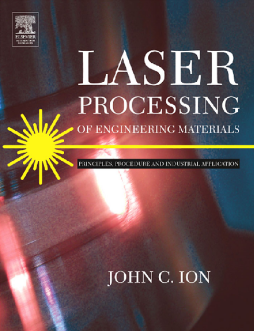
Additional Information
Book Details
Abstract
The complete guide to understanding and using lasers in material processing!
Lasers are now an integral part of modern society, providing extraordinary opportunities for innovation in an ever-widening range of material processing and manufacturing applications. The study of laser material processing is a core element of many materials and manufacturing courses at undergraduate and postgraduate level. As a consequence, there is now a vast amount of research on the theory and application of lasers to be absorbed by students, industrial researchers, practising engineers and production managers. Written by an acknowledged expert in the field with over twenty years' experience in laser processing, John Ion distils cutting-edge information and research into a single key text.
Essential for anyone studying or working with lasers, Laser Processing of Engineering Materials provides a clear explanation of the underlying principles, including physics, chemistry and materials science, along with a framework of available laser processes and their distinguishing features and variables. This book delivers the knowledge needed to understand and apply lasers to the processing of engineering materials, and is highly recommended as a valuable guide to this revolutionary manufacturing technology.
- The first single volume text that treats this core engineering subject in a systematic manner
- Covers the principles, practice and application of lasers in all contemporary industrial processes; packed with examples, materials data and analysis, and modelling techniques
"This is a truly comprehensive text in its coverage of the many diverse ways in which lasers are now used in manufacture, in the depth with which each of these is explored and in the vision for the future with which it coincides. It is a volume of lasting value." M.F. Ashby, University of Cambridge, UK
"...a first-class review of laser technology and ... material processing applications ... John Ion has done a remarkable job of compiling ... a text that’s both educational and instructional, plus it reads well. I strongly recommend this book to those who are contemplating a serious involvement with lasers for material processing. You don’t have to be an undergraduate to get great value from this book." David Belforte, Industrial Laser Solutions July, 2005
"This book is an extremely good resource material for people who want to know anything about lasers. This is the first book of its kind on laser processing that contains a vast amount of information - good & useful information. It will be valuable for researchers, students and especially for the people working in the manufacturing industry. Dr. John Ion has collected latest data on laser processing that will be used for decades to come. An excellent comprehensive work I would say." - Laser Processing of Engineering Materials, June 25, 2005
'John Ion's book is a uniformly excellent treatise on the laser processing of materials. His deep
knowledge of the subject has led to a text which is easy to follow and yet is a state{of{the{art
assessment which will be exploited by researchers. John is a teacher as well as a leading scientist
in all things laser. It is not surprising that the book includes exercises at the end of each chapter
(solutions available free to teachers), a useful glossary, and like all good Ph.D. theses, a final chapter on the future. I am delighted that this book has been written. It is a work of scholarship which will undoubtedly serve us well for the decades to come.' Harry Bhadeshia in Surface Engineering (Volume 21, Number 3, June 2005).
Review by John Powell in The Indusrial Laser User, September 2005
'John Ion has produced a very readable book which covers the whole subject of laser materials processing. There are chapters on everything from the history of laser processing to future opportunities and, of course, plenty of coverage of cutting, welding and surface treatments. It is not surprising therefore that this is not a slim volume - it runs to 545 pages. The style and content are primarily aimed at undergraduate engineers but this book would make a useful addition to the technical library of any commercial user of industrial lasers (for those times when customers or staff ask odd questions - 'what gas should we cut Titanium with?' - 'Can we do laser soldering?' etc.)
Apart from the laser processing stuff there is a whole chapter of information about engineering materials which, for example, explains the different uses of a range of plastics and discusses the various grades of steel and non-ferrous alloys. Judging from the size and scope of the book I expected it to carry a hefty price tag - so I was pleasantly surprised by its actual cost of £39.99
If you are only going to have one laser processing book in your office this would be a good one to choose.'
